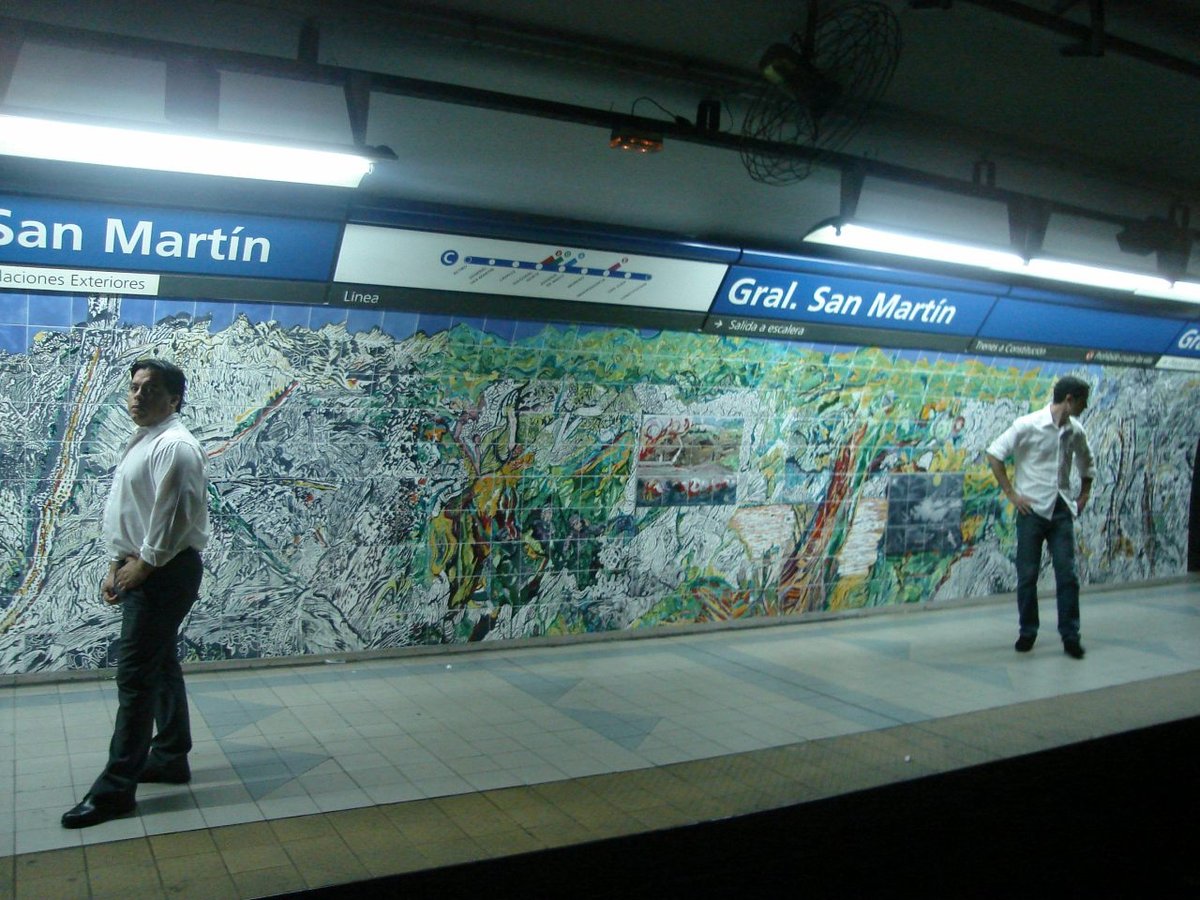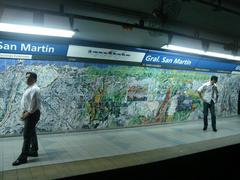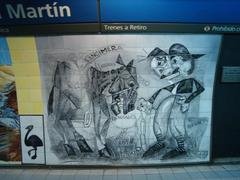
General San Martín Buenos Aires: Visiting Hours, Tickets, and Comprehensive Tourist Guide
Date: 15/06/2025
Introduction to General San Martín’s Legacy in Buenos Aires
A visit to Buenos Aires invites you to trace the extraordinary legacy of General José de San Martín, Argentina’s “Father of the Nation” and a principal architect of South American independence. San Martín’s leadership was pivotal in the liberation of Argentina, Chile, and Peru from Spanish rule. The city honors this national hero through a constellation of iconic sites: the Monumento al General San Martín in the heart of Plaza San Martín, the solemn Mausoleum within the Metropolitan Cathedral, and the Museo Histórico Nacional, among others. These landmarks not only celebrate San Martín’s military genius and diplomatic vision but also reflect the very evolution of Argentina’s national identity and civic pride.
This detailed guide presents essential information on visiting hours, ticketing, accessibility, and thoughtful visitor tips for exploring these sites. Whether you’re inspired by San Martín’s legendary Crossing of the Andes, fascinated by the symbolism of his monuments, or seeking to enjoy the tranquil gardens of Plaza General San Martín, this resource equips you for a rich and memorable journey. It also highlights cultural events and nearby attractions, ensuring your Buenos Aires itinerary is both meaningful and complete (World History Edu, Turismo Buenos Aires, Audiala).
Table of Contents
- Introduction
- Early Life and Military Formation
- Return to South America and Commitment to Independence
- Strategic Vision and the Crossing of the Andes
- Liberation of Chile and Peru
- Legacy and Commemoration in Buenos Aires
- Key Historical Sites and Visitor Experience in Buenos Aires
- Cultural Significance and Modern Recognition
- Practical Tips for Visitors
- Monumento al General San Martín
- Plaza General San Martín
- Mausoleum of General José de San Martín
- Frequently Asked Questions (FAQ)
- Visuals and Interactive Media
- Conclusion and Next Steps
Early Life and Military Formation
José de San Martín was born on February 25, 1778, in Yapeyú, Corrientes Province, Argentina (World History Edu). His formative years unfolded within the colonial landscape of the Spanish Empire in South America. At age seven, San Martín and his family moved to Spain, where he received a formal education and began his military career. He joined the Spanish army as a cadet and gained crucial combat experience in campaigns such as the Peninsular War against Napoleonic France. This training forged the strategic acumen and leadership skills that would later define his role in the South American wars of independence.
Return to South America and Commitment to Independence
After more than twenty years in Spanish military service, San Martín resigned his commission in 1811 and traveled to London. There, he joined a network of Latin American exiles determined to achieve independence from Spain (World History Edu). Inspired by the revolutionary fervor, he returned to Buenos Aires in 1812, joining the United Provinces of the Río de la Plata’s cause for freedom.
San Martín quickly distinguished himself as the leader of the Granaderos a Caballo cavalry regiment, earning acclaim with his victory at the pivotal Battle of San Lorenzo in 1813 (Britannica). This early success established him as a central figure in Argentina’s fight for independence.
Strategic Vision and the Crossing of the Andes
Recognizing that true independence required the defeat of Spanish forces in Lima, San Martín crafted an audacious plan: cross the Andes into Chile, liberate it, and then attack Lima from the Pacific coast (Britannica). From 1814 to 1817, he prepared the Army of the Andes in Mendoza, training and equipping his forces for the perilous journey.
In January 1817, San Martín led about 5,000 men across the Andes—an epic feat likened to Hannibal’s crossing of the Alps. Despite harsh conditions, the army achieved a decisive victory at the Battle of Chacabuco in February 1817, liberating Santiago and laying the groundwork for Chilean independence (World History Edu).
Liberation of Chile and Peru
Following the triumph at Chacabuco, San Martín consolidated Chilean independence with a victory at the Battle of Maipú in 1818. He then organized a naval expedition, landing on the Peruvian coast in 1820. After military and diplomatic maneuvers, he entered Lima in July 1821 and proclaimed Peru’s independence, becoming its Protector (World History Edu). San Martín’s approach combined military prowess with statesmanship, striving for stable governance in the liberated regions.
His historic meeting with Simón Bolívar in Guayaquil (1822) marked a turning point in the final stages of South American independence, though its details remain subject to debate.
Legacy and Commemoration in Buenos Aires
San Martín’s influence endures as a pillar of Argentine and Latin American identity. Known as the “Father of the Nation,” he is celebrated for his commitment to liberty, justice, and unity (Casa Rosada). Numerous monuments, plazas, and institutions in Buenos Aires—and across the continent—bear his name.
Plaza San Martín, with its grand equestrian monument, serves as a focal point for national ceremonies, especially on August 17, the anniversary of his death and a national holiday (Casa Rosada).
Key Historical Sites and Visitor Experience in Buenos Aires
Plaza San Martín
- Visiting Hours: Daily, 6:00 AM–10:00 PM
- Admission: Free
- Features: Equestrian statue of San Martín, landscaped gardens, historic architecture
- Accessibility: Wheelchair accessible
- Tips: Visit during daylight for best photos; special events on August 17 (Turismo Buenos Aires)
Mausoleum of General San Martín (Metropolitan Cathedral)
- Visiting Hours: Mon–Sat 9:00 AM–7:00 PM; Sun 10:00 AM–8:00 PM
- Admission: Free
- Features: San Martín’s tomb, ceremonial guard
- Accessibility: Elevator access
- Etiquette: Modest dress and quiet reflection encouraged
Museo Histórico Nacional
- Visiting Hours: Tues–Sun 11:00 AM–6:00 PM
- Admission: ARS 150 (discounts for students/seniors)
- Features: Independence-era artifacts and exhibits
- Accessibility: Wheelchair accessible
- Guided Tours: Weekends, in English and Spanish; advance booking recommended
These sites are easily reached by public transit or on foot. Many guided tours of Buenos Aires include these landmarks for deeper historical context (Turismo Buenos Aires).
Cultural Significance and Modern Recognition
San Martín’s life is immortalized in Argentine education, art, literature, and public celebrations. Bartolomé Mitre’s 1869 biography “Historia de San Martín y de la emancipación sudamericana” helped cement his status as a foundational national figure (Wikipedia). Today, San Martín’s example resonates not only in Argentina but throughout Latin America, where numerous public spaces and institutions bear his name (World History Edu).
Practical Tips for Visitors
- Best Seasons: Spring (October–November) and autumn (February–April) offer mild weather and vibrant city life (Secrets of Buenos Aires).
- Transport: Efficient and affordable public transit; most sites are walkable from central Buenos Aires.
- Photography: Early morning or late afternoon light is ideal.
- Events: National commemorations, especially August 17, feature ceremonies and tours.
- Tickets & Tours: Book in advance for museums and guided tours during peak periods.
Monumento al General San Martín: Origins, Artistry, and Visitor Information
Origins and Historical Context
The Monumento al General San Martín y a los Ejércitos de la Independencia in Plaza San Martín stands as a powerful tribute to San Martín’s enduring influence. Commissioned after his death in 1850, it was completed in 1862 by French sculptor Louis-Joseph Daumas—the first equestrian statue in Argentina (Wikipedia, audiala.com). Plaza San Martín itself was once the training ground for San Martín’s Granaderos a Caballo cavalry regiment.
Design and Construction
- Sculptors: Louis-Joseph Daumas (statue); Gustav Eberlein (early 20th-century additions)
- Main Features: Bronze equestrian statue atop a granite pedestal, surrounded by neoclassical allegorical figures representing Victory, Freedom, the Andes Campaign, and the Crossing of the Andes
- Bas-Reliefs: Detailed panels depict major independence campaigns
- Dimensions: Monument stands approximately 10 meters (33 feet) tall (Wikipedia)
Symbolism and Artistic Details
The monument’s design captures San Martín’s calm resolve and leadership, with allegorical figures and reliefs illustrating the broader struggle for independence. The use of bronze and granite symbolizes strength and endurance (audiala.com).
Visiting Hours, Tickets, and Tips
- Hours: Open 24/7; free access (audiala.com)
- Best Time: Daylight for optimal viewing and photography
- Getting There: Subway Line C (“San Martín” station); buses 152 and 130; short walk from Retiro train station
- Accessibility: Paved walkways and ramps; some surrounding cobblestone streets
- Special Events: National ceremonies on August 17
Plaza General San Martín: Historical Context and Visiting Guide
Historical Evolution and Setting
Located in Retiro, Plaza General San Martín is among Buenos Aires’ oldest public spaces. Its history spans from a 17th-century monastic sanctuary to a military parade ground and, later, a landscaped urban park (Aguiar Buenos Aires). Designed by Charles Thays, the plaza features lush lawns, native and exotic trees, and striking views over Retiro and the Río de la Plata (Lonely Planet).
Layout, Features, and Landmarks
- Monumento al Libertador General San Martín: Central equestrian monument, site of official commemorations (Expat Pathways)
- Malvinas War Memorial: Eternal flame and engraved names honoring fallen soldiers (Lonely Planet)
- Other Landmarks: Kavanagh Building (Art Deco), Palacio San Martín (Beaux-Arts, Foreign Ministry), Círculo Militar and Museo de Armas, Torre Monumental (clock tower), Plaza Hotel (Turismo Buenos Aires, GoToBuenosAires)
Visiting Hours, Tickets, and Tours
- Hours: Daily, 6:00 AM–10:00 PM
- Admission: Free
- Tours: Guided walks available; book in advance for deeper context
- Accessibility: Wheelchair accessible, with paved paths and nearby restrooms
- Transport: Metro Line C (“San Martín” station); multiple bus lines; close to Retiro station
Cultural and Social Life
Plaza San Martín is a hub for relaxation, cultural events, exhibitions, and public celebrations. It is a favored gathering spot for locals and tourists, with literary connections to Jorge Luis Borges (GoToBuenosAires).
Mausoleum of General José de San Martín: Hours, Tickets, and Visitor Tips
Location and Access
Located inside the Metropolitan Cathedral at Reconquista 30, the Mausoleum of General José de San Martín is in the city’s historic center, near Plaza de Mayo (Evendo). Access is simple via subway (Line C, “Catedral” station), bus, or a short walk from Avenida 9 de Julio.
Visiting Hours and Tickets
- Hours: Follows cathedral schedule—typically open daily from morning to early evening
- Admission: Free; no tickets required
- Occasional Closures: During religious services or national events (Evendo)
Visitor Experience
- Highlights: San Martín’s ornate tomb, statues representing Argentina, Chile, and Peru, and displays of artifacts and documents
- Atmosphere: Quiet, respectful, and reflective
- Accessibility: Elevator and ramps available; some steps or uneven flooring in parts
- Etiquette: Modest dress and calm behavior; photography usually allowed without flash
Practical Tips
- Best Time: Weekday mornings or early afternoons for a quieter experience
- Safety: Central area is safe during the day; remain alert to avoid pickpockets (Map and Camera)
- Language: Spanish is predominant; basic English may be spoken by staff
- Currency: Argentine peso (ARS); cash preferred for small purchases
- Nearby Attractions: Plaza de Mayo, Casa Rosada, Teatro Colón, San Telmo Market (Touropia, Miss Tourist)
Special Events and Guided Tours
Commemorative ceremonies are held on national holidays such as Independence Day (July 9) and San Martín’s Day (August 17). Many walking tours of Buenos Aires include the mausoleum (Argentina Travel).
Frequently Asked Questions (FAQ)
Q: Are the main San Martín sites free to enter?
A: Yes, entry is free for Plaza San Martín, the mausoleum, and most outdoor monuments. Museums may charge a small fee.
Q: What are the main visiting hours?
A: Plaza San Martín: 6:00 AM–10:00 PM; Mausoleum: aligns with cathedral hours (usually morning–early evening).
Q: Are these sites accessible for visitors with disabilities?
A: Most have paved paths and ramps; some older buildings may have limited access.
Q: Are guided tours available?
A: Yes, guided tours for individuals and groups can be booked through local operators or at museums.
Q: Can I take photographs?
A: Generally yes, but flash or tripod use may be restricted indoors.
Visuals and Interactive Media
Enhance your visit with images of the equestrian monument, the mausoleum’s interior, and the lush surroundings of Plaza San Martín. Many official tourism websites and apps offer virtual tours and interactive maps to help plan your route.
Conclusion and Next Steps
Exploring General José de San Martín’s legacy in Buenos Aires is a journey into Argentina’s soul—a chance to witness the monuments, museums, and plazas that commemorate the country’s fight for freedom. With free access, convenient transport, and a wealth of cultural offerings, Buenos Aires welcomes you to discover and honor the liberator’s enduring spirit.
For the latest updates, guides, and virtual resources, download the Audiala app and follow local tourism authorities. Plan your visit around national commemorations or seasonal highlights for an even more rewarding experience. Embrace the opportunity to connect with Argentina’s history and be inspired by the life and ideals of General José de San Martín.
Sources
This article references the following resources for accuracy and further exploration:
- World History Edu: Life and Major Accomplishments of José de San Martín
- Britannica: José de San Martín Biography
- Casa Rosada: José de San Martín: The Liberator Hero and His Immortal Legacy
- Audiala: Equestrian Statue of José de San Martín
- Turismo Buenos Aires: Plaza San Martín Buenos Aires
- Lonely Planet: Plaza San Martín
- Evendo: Mausoleum of General José de San Martín
- Map and Camera: Is Buenos Aires Safe?
- Argentina Travel: Holidays in Argentina 2025
- Miss Tourist: 12 Things You Cannot Miss in Buenos Aires
- GoToBuenosAires: Plaza San Martín Buenos Aires
- Aguiar Buenos Aires: Praça San Martín
- Expat Pathways: Sculptures and Monuments in Buenos Aires
- Secrets of Buenos Aires: Travel Checklist
- Wanderlust Photos Blog: Buenos Aires Tourist Guide
- Touropia: Tourist Attractions in Buenos Aires































































































































































